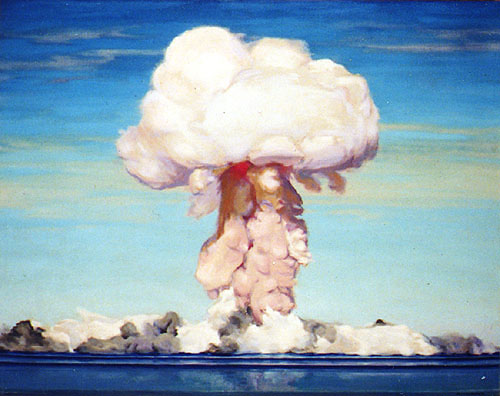Revision a0d8270b730e7d9dff406a2b7f18ed5b0206fe3e
Wednesday Workshops
Sit Wherever You’d Like!
Given that in Look Magazine’s article by William Bradford Huie it is mentioned that the “The majority … of the white people in Mississippi 1) either approve Big Milam’s action or else 2) they don’t disapprove enough to risk giving their”enemies" the satisfaction of a conviction" whereas, a New York Times article on the same topic by John N. Popham claims that “the slaying of Emmett Till …brought strong criticism of the [Mississippi’s] white supremacy practices from other sections of the country”, is it fair to say that race relations differed across the country? Do we similar inconsistencies throughout the country when it comes to civil rights and other social activism throughout the 1960s and 1970s?
After World War II, did white attitudes about racial minorities differ by region in the United States? If so, how?

Painting by Charles Bittinger of the Atom Bomb explosion in the Bikini atoll
Source: http://www.history.navy.mil/ac/bikini/bikini2.htm
After World War II, did white attitudes about racial minorities differ by region in the United States? If so, how?
If all we had were the readings assigned for today, how would we answer this question?
For Five Minutes:
After World War II, did white attitudes about racial minorities differ by region in the United States? If so, how?
If your username ends with …
- 01 or 02: Look at Film clips
- 03 or 04: Look at Reading #1
- 05 or 06: Look at Reading #2
- 07 or 08: Look at Reading #3
- 09 or 10: Look at Reading #4
- 11 or 13: Look at Readings #5 and #6
If you need additional information about any of the sources to determine the relevance of your source, look it up using our Reference Tools or by asking.
For Ten Minutes
In groups of the three people sitting around you, locate any readings, film clips, pieces of information, or images that might support our initial answer to the question.
Pick one person in your group to be the “Devil’s Advocate.” This person is responsible for finding evidence that challenges our answer.
The information from the comic book hearing with William Gaines helps to gain a better understanding of how comic books shifted to a more propaganda type focus as we saw with Supergirl and seatbelts in 1987. This is in great contrast to the blood and gore published by William Gaines prior to the Comic Code of 1954. Here we see that comics as seen in 1987 were not always so censored, but regulations put in place (such as the Comic Code) forced these publishers to adapt their content to what the lawmakers deemed appropriate. Thus we see that the views of comics changed from being accepted while gory (pre-1954) to being vilified for being so. From this reading we know that people were uncomfortable with horrific scenes of blood and gore as well as presentations of criminals as deserving of empathy in 1954. This view of comics led to the creation of more conservative comic books that often just reinforced some proposition the government did approve of (i.e. wearing seatbelts). This reading does not though tell us how comic books arrived at the more controversial portrayals we see in Gaines’ comic and if there were many other comics of the sort at the time.
Between the 1940s and the 1990s, Americans grew less and less concerned by the depiction of graphic sex and violence in entertainment media.
What evidence supports this position? What evidence challenges it?
